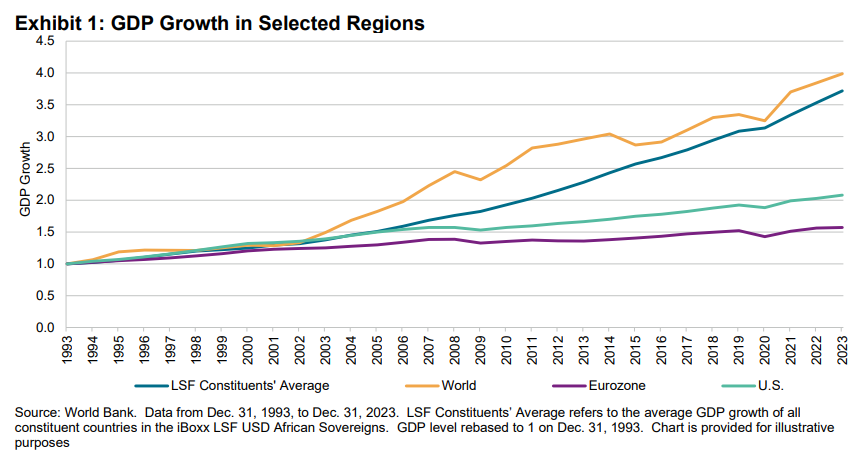Introduction
Launched in June 2024, the iBoxx LSF USD African Sovereigns measures the performance of USD-denominated bonds issued by sovereign African entities that are domiciled in the African countries eligible for the Liquidity & Sustainability Facility (LSF) repo facility. The index, launched in collaboration with LSF, aims to aid the LSF in its objective to improve African sovereign eurobonds’ liquidity and sustainability by leveraging S&P Dow Jones Indices’ fixed income capabilities.
Development of Africa
Africa is the second-largest continent by size and has 54 countries, the highest number among all continents. Although gross domestic product (GDP) per capita is currently the lowest of all continents, Africa has plenty going for it in the decades ahead: rapid population growth, high fertility rates and a low median age, which could be engines of future economic growth. The current population is over 1.4 billion, the second-highest continent after Asia.
Looking at the last three decades up to 2023, the GDP of the countries that comprise the iBoxx LSF USD African Sovereigns has almost quadrupled, roughly in line with the world’s GDP growth and significantly better than the eurozone and the U.S.

African development in the past two decades has been supported by population growth: the annual growth rate of the population has remained above 2% over recent decades, resulting in the continent’s population doubling from fewer than 700 million in 1993 to about 1.4 billion at the end of 2023. While the growth rate has been declining slightly in recent years, the population continues to increase. The continent is forecast to reach nearly 2.5 billion inhabitants by 2050 with rapid population growth, high fertility rates, low median age, increasing life expectancy, large households, and widespread poverty being the main features of Africa's current demographics.
While Africa has the potential to realize a significant demographic dividend, the continent needs to find ways to reap those benefits and fulfil its potential. Major investment in infrastructure, healthcare and education, as well as improved governance, are likely to be key to unlock the continent’s potential.
There remains plenty to do with respect to the former and the latter. According to the Human Sciences Research Council, political stability across the continent overall has not improved, and it declined slightly in the five years between 2016 and 2021, although there has been wide divergence across individual countries. Apart from better governance, significant investment is also needed in Africa’s physical and human capital, which requires stable, reliable and low cost funding in the decades ahead.















































